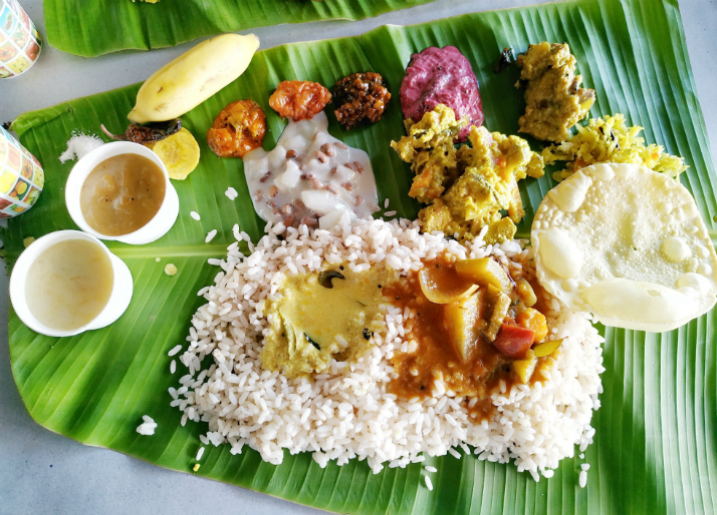Why South Indian People Served food on banana leaf?
In a few south Indian
states, it is customary to serve nourishment on banana takes off. Visitors are
given the top a portion of the leaf while relatives are given the lower parts.
Everyone sits together on the floor and eats with their hands. Rice, meat, vegetables,
lentils, curries and pickles are all served on the same leaf, since it is
sufficiently extensive to convey an entire dinner.
Eating on banana
leaves is a custom that goes back a huge number of years, notwithstanding it
its advantages are still important today.
Healthy
Banana leaves are packed with plant-based compounds called polyphenols such as
epigallocatechin gallate, or EGCG, which is also found in green tea.
Polyphenols are natural antioxidants that battle free radicals and prevent
diseases. While banana leaves are not easy to digest if eaten directly, the
food absorbs the polyphenols from the leaves, so that you get the benefit of
the nutrition.
It is also believed
that the leaf has anti-bacterial properties that kill all the germs in the food,
thereby reducing the chances of you falling sick.
Flavorful
Banana leaves have a waxy coating that has a subtle but distinct flavor. When
hot food is placed on the leaves, the wax melts and lends its flavor to the
food, making it taste better.
Eco-friendly
Most people use plastic or Styrofoam plates when they need disposable utensils,
however banana leaves are a much more eco-friendly option. They decompose in a
very short time, unlike plastic, which takes hundreds of years to biodegrade.
Hygienic
Banana leaves do not require a lot of cleaning - they just need to be rinsed
with a little water and they are ready to use. If you are eating at a place
where the hygiene standards are questionable, you are much better off eating
from a banana leaf than from a plate that has not been cleaned properly.
Chemical-free
Since plates are washed with soap and water, traces of the chemicals in the
soap may still remain on the plates, contaminating your food. Banana leaves
just need to be rinsed with a little water, and do not need to be washed with
soap, so your food will be chemical-free.
Practical
the banana leaf is quite large, making it capable of holding an entire meal
that consists of several different components. The leaves are also largely
waterproof, thanks to their waxy coating, so they can hold gravy preparations
without getting soggy.
Apart from the health reasons that have
already been stated, Banana tree conveys a very deep spiritual symbology.
Banana is one of those trees/plants that dies after giving only
ONE bunch. And that is why banana leaf, trunk, leaves and in some occasions the
flower tip are placed in the rituals to remind us (loudly) to OFFER our life to
the divine because just as Banana tree had one life to be in service of the
Divine, we too have only one life to offer in the service of Divine. On every occasion
related to prayers and offerings to God, Banana (fruit/leaf/trunk) is used to
REMIND us to not to squander our life and use it in service of Divine (that
includes fellow humans).
Eating food is one the most spiritual activities one can do
(apart from breathing and seeing) and use of Banana leaf is to serve as
reminder to offer the food to divine before devouring it.
The water would be blessed and sprinkled on the leaf before the
food is served and we now know scientifically that blessing water changes its molecular structure
and may literally make the food itself Holy. This later became customary
washing of the leaves and to this day people sprinkle water before placing food
without possibly knowing why.
Logically and
historically, food was served on leaf since long ago. I've seen some of the
examples in Gujarati wedding in typical village where food was served using
"Khakhra" leaves typically called "Padiya-Patrada" which
means leaves jointed for serving food. The disposal glasses and concept of
dispose of after using the dish, or say disposable dishes or use & throw
material was started with this concept in food industries.
Though I am not
familiar with South Indian Culture but I had seen somewhere, that the Banana
leaf is big enough to cover the range of food. I've seen the people eating on
Banana Leaf and it is symbolize as icon of unity, logic I have to mention here
is, most probably South Indian people used to eat Dal-Rice and very few recipes
on Banana Leaf, and mix all the things, which denotes the symbol of unity.
While of you see
someone who is eating on Banana Leaf, after having meal the person whosoever is
eating will show the gesture to the one who made the food. The gesture can be
expressed in this way, if the one who ate the food and fold it on his own side,
means they really likes the food and on the contrary if the one who ate the
food, fold on the side of the person whosoever is serving the food, means the
one who ate don't like the food much.
With reference to the
Western Culture, they have hospitality manners while having food in hotels, say
for an example if the one who is completed the meal, expressed gesture by
putting spoons in the "X" shape and shows that he completed the meal.
I am little bit biased and saying that, this is not the proper gesture or not
showing any emotion just like English Language has no words for respecting
elder person, but in the Indian Culture we are having emotions and we have the
proper way to show the emotions just like Hindi Language having various words
for respecting elder person.





1 Comments
Cricket ID
ReplyDelete